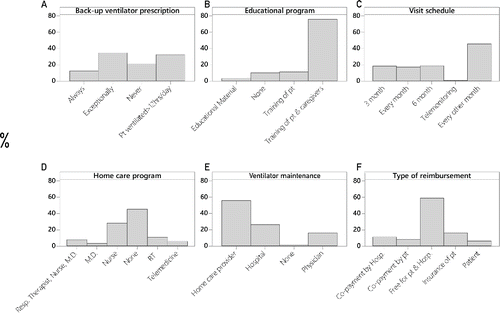Figures & data
Table 1. Response rate and respondents characteristics.
Figure 1. Percentage of domiciliary NIV prescriptions in COPD patients among countries. Abbreviations: ERS = members of European Respiratory Society (ERS) assembly on NIV; ALL = all respondents.
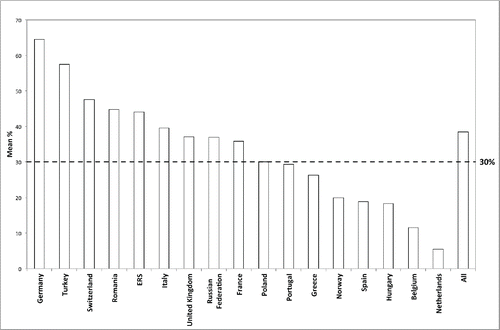
Figure 2. (A) Frequency distribution graph of rank values rated by physicians for each expected benefit from domiciliary NIV. Rank value range is from 1 (Important) to 9 (Irrelevant). Mean rank value for each variable is expressed at the bottom, in each panel. (B) Ranking order of expected benefits as explored by multivariate analysis. Only the first component of principal component analysis was plotted. Abbreviations: FEV1 = FEV1 improvement; Exercise tolerance = Exercise tolerance improvement; Quality of life = Quality of life improvement; Admission reduction = Reduction of hospital admission; Sleep quality = Sleep efficacy amelioration; Exacerbations Reduction = Reduction of exacerbations frequency; Kendall's W = Kendall's coefficient of Concordance.
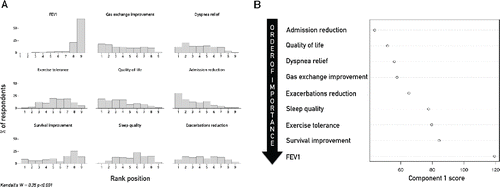
Figure 3. (A) Frequency distribution graph of rank values rated by physicians (physicians’ rating) for each decision to start NIV. Rank value range is from 1 (Irrelevant) to 5 (Very Important). Mean value for each variable is expressed at the bottom, in each panel. (B) Importance rating of decisions to start NIV as explored by multivariate analysis. Only the first component of principal component analysis was plotted. Abbreviations: PaCO2 > 55 = PaCO2 > 55 mmHg; PaCO2 > 45 + Desaturation = PaCO2 > 45 mmHg + nocturnal desaturation; PaCO2 > 45 + hospital admission = PaCO2 > 45 mmHg + frequent hospitalization; >3 AHRF = Recurrent (>3) Acute Hypercapnic Respiratory Failure (AHRF) episodes requiring NIV; Increase PaCO2 under O2 = Increase in PaCO2 under oxygen; Failure to wean = Failure to wean from NIV: Kendall's W = Kendall's Coefficient of Concordance.
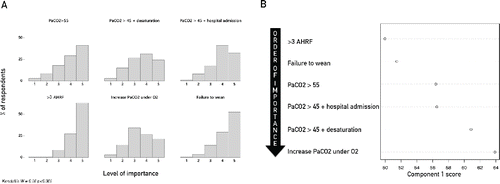
Figure 4. (A) Frequency distribution graph of rank values rated by physicians for each procedure performed before starting NIV. Rank value range is from 1 (Very important) to 6 (Irrelevant). Mean rank value for each variable is expressed at the bottom, in each panel. (B) Ranking order of procedure performed before starting NIV as explored by multivariate analysis. Only the first component of principal component analysis was plotted. Abbreviations: MIP = Maximum inspiratory pressure; 6MWD = 6 minutes’ walking distance; QoL assessment = Quality of life assessment; Kendall's W = Kendall's Coefficient of Concordance.
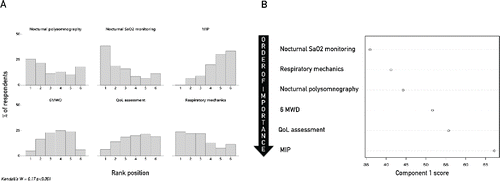
Figure 5. Ventilation mode utilization for domiciliary NIV in severe stable COPD patients. Abbreviations: PSV Low = PSV with low inspiratory support (Pressure support < 20 cm H2O); PSV High = PSV with high inspiratory support (Pressure support > 20 cm H2O); PCV = Pressure control ventilation; VCV = Volume control ventilation; PSV-Vtg = Pressure support with volume guarantee.
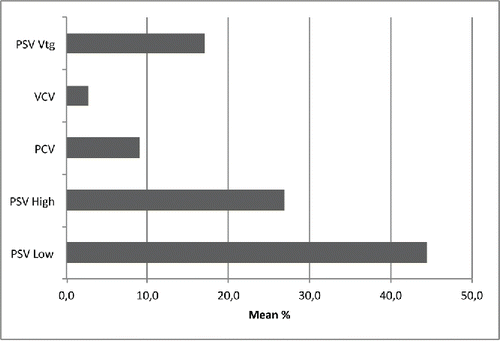
Figure 6. Ventilation mode distribution by country. Abbreviations: PSV Low = PSV with low inspiratory support (Pressure Support < 20 cm H2O); PSV High = PSV with high inspiratory support (Pressure Support > 20 cm H2O); PCV = Pressure control ventilation; VCV = Volume control ventilation; PSV-Vtg = Pressure support with volume guarantee; ERS = members of European Respiratory Society (ERS) assembly on NIV; ALL = all respondents.
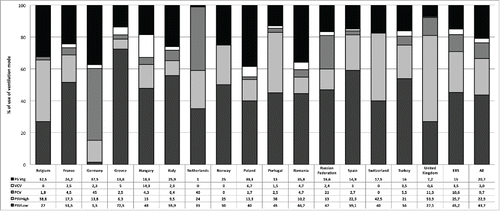
Figure 7. Interface utilization for domiciliary NIV in COPD patients. Nasal = nasal mask; Oronasal = oronasal mask; Fullface = fullface mask; Rotational = rotational strategy.
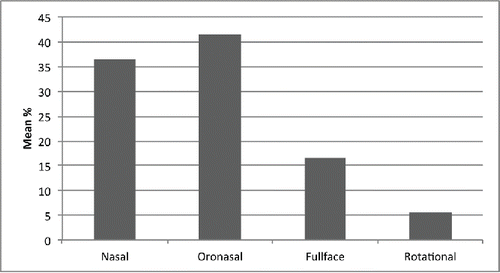
Figure 8. Logistic management of COPD patients on domiciliary NIV. Each panel represents the distribution (percentages) of physicians’ responses for: a) Back-up ventilator prescription; b) Educational program = Type of educational program before NIV prescription; c) Visit schedule = Frequency of scheduled visits; d) Home care program = Type of home care program; e) Ventilator maintenance = Responsibility of ventilator management and technical assistance; f) Type of reimbursement. Abbreviations: Pt = patient, M.D. = physician; RT = respiratory therapist; Hosp. = hospital.
